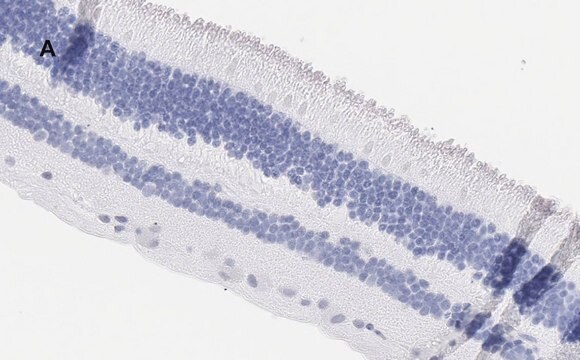추천 제품
생물학적 소스
mouse
Quality Level
항체 형태
purified immunoglobulin
항체 생산 유형
primary antibodies
클론
3F4, monoclonal
종 반응성
hamster, human
제조업체/상표
Chemicon®
기술
ELISA: suitable
immunohistochemistry (formalin-fixed, paraffin-embedded sections): suitable
immunoprecipitation (IP): suitable
western blot: suitable
동형
IgG2a
NCBI 수납 번호
UniProt 수납 번호
배송 상태
dry ice
타겟 번역 후 변형
unmodified
유전자 정보
human ... PRNP(5621)
일반 설명
Prions are thought to cause a number of diseases in a variety of mammals, including bovine spongiform encephalopathy (BSE, also known as "mad cow disease") in cattle and the Creutzfeldt-Jakob disease (CJD) in humans. All thus-far hypothesized prion diseases affect the structure of the brain or other neural tissue, and all are currently untreatable and thought to be fatal. Prions are hypothesized to infect and propagate by refolding abnormally into a structure which is able to convert normal molecules of the protein into the abnormally structured form. All known prions induce the formation of an amyloid fold, in which the protein polymerises into an aggregate consisting of tightly packed beta sheets. This altered structure is extremely stable and accumulates in infected tissue, causing cell death and tissue damage. This stability means that prions are resistant to denaturation by chemical and physical agents, making disposal and containment of these particles difficult.
특이성
Prion protein, amino acid residues 109-112 of human, hamster and feline. Does not react with PrP from any other mammalian species. MAB1562 is reactive to native and denatured forms of PrP. Tissue or cells which have been fixed requires that the epitope be re-exposed (see below). Recognizes both protease sensitive and protease resistant forms of PrP.
면역원
Epitope: a.a. 109-112
애플리케이션
Immunohistochemistry(paraffin):
Representative images from a previous lot. Optimal Staining With Citrate Buffer, pH 6.0, Epitope Retrieval: Human Brain
Immunohistochemistry (Kitamoto et al., 1987):
1:100-1:1,000 *See protocol below.
Epitope must be re-exposed in fixed tissue by pretreatment of tissue using one of the following procedures:
a. formic acid for 10 minutes at room temperature (Kitamoto et al., 1987)
b. hydrolytic autoclaving (Kitamoto et al., 1991)
c. microwaving (BioGenex, San Ramon, CA)
Western Blot: (Kascsak, R.J., 1991; Kascsak, R.J., 1987):
1:10,000-1:100,000 dilution of a previous lot was used.
Immunoprecipitation: (Kascsak, R.J., 1991; Kascsak, R.J., 1987):
1:10-1:100 dilution of a previous lot was used.
ELISA: (Kascsak, R.J., 1991; Kascsak, R.J., 1987):
1:100,000 dilution of a previous lot was used.
Optimal working dilutions must be determined by end user.
Representative images from a previous lot. Optimal Staining With Citrate Buffer, pH 6.0, Epitope Retrieval: Human Brain
Immunohistochemistry (Kitamoto et al., 1987):
1:100-1:1,000 *See protocol below.
Epitope must be re-exposed in fixed tissue by pretreatment of tissue using one of the following procedures:
a. formic acid for 10 minutes at room temperature (Kitamoto et al., 1987)
b. hydrolytic autoclaving (Kitamoto et al., 1991)
c. microwaving (BioGenex, San Ramon, CA)
Western Blot: (Kascsak, R.J., 1991; Kascsak, R.J., 1987):
1:10,000-1:100,000 dilution of a previous lot was used.
Immunoprecipitation: (Kascsak, R.J., 1991; Kascsak, R.J., 1987):
1:10-1:100 dilution of a previous lot was used.
ELISA: (Kascsak, R.J., 1991; Kascsak, R.J., 1987):
1:100,000 dilution of a previous lot was used.
Optimal working dilutions must be determined by end user.
This Anti-Prion Protein Antibody, a.a. 109-112, clone 3F4 is validated for use in ELISA, IH, IH(P), IP, WB for the detection of Prion Protein.
품질
Immunohistochemistry(paraffin):
Prion Protein (cat. # MAB1562) staining pattern/morphology in normal brain. Tissue was pretreated with Citrate, pH 6.0. This lot of antibody was diluted to 1:500, using IHC-Select Detection with HRP-DAB. Immunoreactivity is seen predominantly as cell body staining of neurons.
Optimal Staining With Citrate Buffer, pH 6.0, Epitope Retrieval: Human Brain
Prion Protein (cat. # MAB1562) staining pattern/morphology in normal brain. Tissue was pretreated with Citrate, pH 6.0. This lot of antibody was diluted to 1:500, using IHC-Select Detection with HRP-DAB. Immunoreactivity is seen predominantly as cell body staining of neurons.
Optimal Staining With Citrate Buffer, pH 6.0, Epitope Retrieval: Human Brain
표적 설명
12.3 kDa
물리적 형태
Format: Purified
Purified mouse monoclonal IgG2a in buffer containing PBS and no preservative.
법적 정보
CHEMICON is a registered trademark of Merck KGaA, Darmstadt, Germany
적합한 제품을 찾을 수 없으신가요?
당사의 제품 선택기 도구.을(를) 시도해 보세요.
Storage Class Code
12 - Non Combustible Liquids
WGK
WGK 2
Flash Point (°F)
Not applicable
Flash Point (°C)
Not applicable
시험 성적서(COA)
제품의 로트/배치 번호를 입력하여 시험 성적서(COA)을 검색하십시오. 로트 및 배치 번호는 제품 라벨에 있는 ‘로트’ 또는 ‘배치’라는 용어 뒤에서 찾을 수 있습니다.
Reference materials for the evaluation of pre-mortem variant Creutzfeldt-Jakob disease diagnostic assays.
J K Cooper,K Ladhani,P D Minor
Vox Sanguinis null
Synaptic prion protein immuno-reactivity in the rodent cerebellum.
A M Haeberle, C Ribaut-Barassin, G Bombarde, J Mariani, G Hunsmann, J Grassi, Y Bailly et al.
Microscopy Research and Technique null
Sialylated and O-glycosidically linked glycans in prion protein deposits in a case of Gerstmann-Straussler-Scheinker disease.
Viviana Zomosa-Signoret,Miguel Mayoral,Daniel Limon,Blanca Espinosa,Minerva Calvillo et al.
Neuropathology : Official Journal of the Japanese Society of Neuropathology null
Phospholipid composition of membranes directs prions down alternative aggregation pathways.
Robinson, PJ; Pinheiro, TJ
Biophysical Journal null
Brain microglia were activated in sporadic CJD but almost unchanged in fatal familial insomnia and G114V genetic CJD.
Shi, Q; Xie, WL; Zhang, B; Chen, LN; Xu, Y; Wang, K; Ren, K; Zhang, XM; Chen, C; Zhang, J; Dong, XP
Virology Journal null
자사의 과학자팀은 생명 과학, 재료 과학, 화학 합성, 크로마토그래피, 분석 및 기타 많은 영역을 포함한 모든 과학 분야에 경험이 있습니다..
고객지원팀으로 연락바랍니다.








